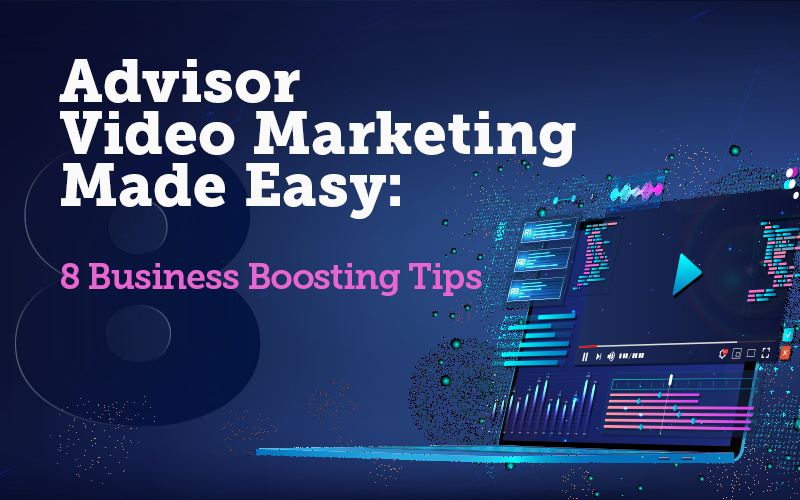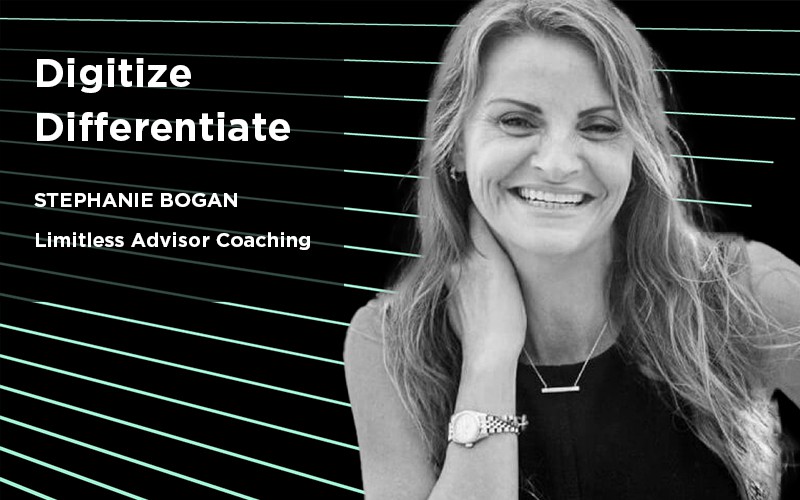Like those old Virginia Slims commercials used to say, video marketing has come a long way baby! More advisors are using video to connect and engage with consumers, but the “rules” regarding what works and what doesn’t work continue to evolve. Video can be one of the most effective marketing tools in your toolbox, if you know how to use it. We’ve got eight “why didn’t I think of that” tips to employ now to transform your advisor video marketing strategy into a business boosting machine.
Key Takeaways:
- You need to get to your “why” first. We explain how below.
- People want to connect with people.
- Low- to no-cost tools, like Loom and Vidyard, help you produce and edit videos with ease.
- Short-form videos reign supreme, get to the point.
- Videos don’t need to be professionally produced to be effective. Grab your phone and start recording.
- Storytelling is key. Share your personal stories and ask happy clients to do the same (testimonials).
Is video really that much better than other forms of content?
YES! According to Laura Garfield of Idea Decanter (more on Garfield below), an email with video gets 200% more engagement than an email without video. Eons ago, 3M Corporation extolled this stat: We can process visuals 6,000 times faster than text.
Plus, video converts better than other forms of content. According to Vidyard’s 2022 Benchmark Report, “Nearly 70% of sellers say that video converts better than any other form of content they use, and customer experience professionals report even higher success rates. Overall, 93% of study participants believe that video converts the same or better than other forms of content.”
At InsurMark, we’re big proponents of financial advisor video marketing because, well, video works, as the stats above and research with our own advisors shows. And that’s why Virtual CMO Jack Martin invited Idea Decanter’s Laura Garfield to join him on a recent episode of The Breakthrough Advisor podcast. Garfield and her team partner with financial advisors to help them “Get ROI with Video.”
During the podcast, Martin and Garfield discussed the evolution and impact of video in financial services marketing and shared tips on how advisors can use video to deepen client relationships. Before we hop into the tips, let’s take a quick look at the evolution of advisor video marketing and how things have changed.
How are financial advisors using video today?
According to Garfield, “We were very early adopters in the use of video. And I think it’s evolved a lot. I would say in the last 12 to 15 months it’s really exploded in terms of advisors embracing the concept and starting to use it and invest in it. And I think there’s a lot of nuance to it now that wasn’t there before. The biggest trend we’re seeing right now is in snackable content, that short format video content, as attention spans get shorter and shorter.”
Martin, who was a CFP® and co-founder of Elite Advisor Group, prior to venturing into marketing, says, “The thing I hope advisors embrace is the concept that video can be an alternative to text and to phone calls. And in certain instances, it can be an alternative to a face -to-face, IRL situation, right? I think the canned, produced, step, rinse and repeat background kind of videos may have been an early iteration. But people want to connect with people. Maybe this whole COVID thing was catalyst to get us further down the path of video.”
So how do you expand your advisor video marketing strategy and do so in an impactful way? Let’s move on to those tips …
Eight Video Marketing Tips for Advisors
Tip No. 1: Take time to figure out your ‘why.” Here’s how.
“Before you decide what to say and how to say it, you have to know who you’re talking to. So, one of the first steps when you are creating video content is really to decide what am I trying to accomplish with this and who am I trying to reach, so that you can develop a message that really resonates with that audience,” explains Garfield.
She believes the most powerful video an advisor can put out there is one that tells their “why” story. How do you get to your “why?” Go through the Seven Whys Process, as follows:
- Start by asking yourself, “Why do I do what I do?”
- Write down or record your answer on your phone, and then ask yourself, “But why?”
- Repeat the process seven times, going deeper each round, until you get to a point where you land on something you believe would resonate with people.
- Try out your “why” story on people you trust, then go deeper and adjust if necessary.
When do you know you’ve hit on your “why?”
According to Martin, “Until you get to the point where you can see the nexus between your story and who you want to be your client, you haven’t gone deep enough. Your clients don’t care about your story until they know you care about their story. Just drill down a little bit more to get that overlap, because that’s really where the magic happens.”
Adds Garfield, “I love the acronym, the WIIFM, the what’s in it for me. And when it comes to crafting a great why story, it’s about getting personal and telling a story that’s memorable and then building the bridge to your prospects and why they should care about it.”
FYI, your story can change over the years, too. Garfield shares her “why” story and how it has evolved on the podcast, so check it out.
Tip No. 2: Know when to go ‘polished’ and when to ‘be authentic.’
As Garfield explains, “There’s been an evolution in the decade we’ve been doing this in the acceptance of a more DIY-looking video. Back in 2014, 2015, you really needed it to be highly polished. I think these days, and probably as part of a byproduct of COVID, the DIY kind of look, the less polished, is definitely more accepted. But I would say when it comes to someone’s first impression with your brand, having something that is more polished can be important.”
Martin agrees. “Yeah, I think when folks are in that awareness stage, and they’re starting to suss out whether you’re a viable option for them, I agree with you 100%. It’s part of that online presence, online research sort of proposition when dealing with prospects.”
Tip No. 3: Edit videos like a pro with free video editing tools.
Producing videos doesn’t have to be difficult or expensive! Garfield and her team use Loom, while Martin and his team use Vidyard. Both platforms offer free and paid options, so it’s easy to dip your toes into the video waters for little to no cost, then upgrade if needed.
Tip No. 4: Get to the point with ‘snackable bites.’
“There are different jobs for videos. Some are for marketing and nurturing client relationships, and some are for more on the prospect side. In 2014, when we started, I would say the average video we created for folks at the top of the funnel—those prospects just getting to know you—was maybe around three minutes. That has shrunk to about two minutes these days,” Garfield says.
According to Hubspot’s State of Marketing 2024 Industry Trends Report, short-form video DELIVERS as the #1 format marketers use, offering the highest ROI. The format is also projected to see the most growth in 2024.
Garfield has found there are many ways to use short format content that’s either 60 seconds or even 30 seconds or less, though there is still a place for slightly longer videos, especially at the getting-to-know-you phase. “It says a lot about how we’re consuming video content, how much we’re seeing and the shrinking of our attention spans,” she says.
Tip No. 5: Get personal, share your stories.
As mentioned earlier, people want to connect with people. Garfield has found sharing something personal in a video works well. She uses Loom to record a video once a quarter for partners of Idea Decanter. Financial advisors can apply this method equally well with their and their advisory practice’s centers of influence (COIs).
As Garfield explains, “I do it in a really lowbrow kind of way. And for this partner update video, I just dig up something personal that’s going on with me because all of our partners do know me, and people connect with people. I drop it into an email, write a little personal note and send it out. And I always get great feedback. I would say 75 % of those emails then launch into a different kind of discussion about, how can we be better partners, and what can we do next?
“When it comes to being memorable, it’s all about the story because we walk away from interactions with people remembering less the statistics, less the bullet points and the takeaways and more about how someone made us feel and the story they told.”
Tip No. 6: Say ‘NO’ to plain hyperlinks and ‘YES’ to thumbnails in emails.
We said it above and we’ll say it again: Emails with video get 200% more engagement than emails without video, according to Garfield. She has also found that using a thumbnail from the video with a play button (linking to the video) is much more effective than simply dropping in a hyperlink alone.
Says Garfield, “You can make your audience feel like they are being spoken to directly by including what we call a thumbnail with a play button. It’s just a screen grab of some piece of your video with your face in it with a play button on it. When you drop that into even a simple Outlook email and hyperlink that image to the video, when people open the email, they immediately know this is an email from you, because they see your face. It is not canned content.”
Tip No. 7: Use the word ‘video’ in email subject lines.
“Another advisor video marketing hack is to make sure you put the word video in the subject line because our inboxes are becoming more and more crowded. If you’re trying to stand out in an inbox, letting people know that there is a video will get more clicks, more opens for the email itself,” says Garfield.
This is another “Pro” tip from Garfield, who has mountains of data on email open rates from her years of partnering with financial advisors to help them boost ROI with video. You can take her word for it.
Adds Martin, “A group we work with out in California that does neuroscience research, what they tell us is that today most of us get some level of anxiety when we have to go into our inboxes. There’s so much there. So, when you see that word video, it’s kind of like an Oasis, you know at least what’s inside could be a little bit more interesting.”
Tip No. 8: Embrace storytelling for customer testimonial videos, too.
Testimonials are always a good thing (when done right). Customer testimonial videos allow you get your authentic story out there, while meeting compliance requirements at the same time. But the storytelling aspect of these videos is key.
According to Garfield, “You absolutely can use client testimonial videos in your marketing as long as you follow what the SEC laid out for you. So, when it comes to identifying the best people, go back to your target audience, your ideal clients, and then ask them. You will be surprised how excited clients who have been with you for awhile will be that you asked them to be in a client testimonial video.
“I also think, we’ve said it over and over, stories are what make us memorable. A really powerful testimonial video isn’t just someone saying great things about you. It’s actually sharing some of their own story. And what you’re trying to do is get a prospect to see themselves in the video and start identifying so they are mentally building a bridge to, ‘You are my answer.’”
Martin and Garfield share more great tips and advisor video marketing hacks in the podcast, so check it out!
We can connect you with marketing resources top advisors rely on
From our proven Value Engineering Process to Hubbard, our proprietary, industry-leading advisor business platform and more, InsurMark has the tools, technology, training and mentorship you need to grow your 20th century advisor practice. Contact us at (800) 752-0207 or connect with us online to schedule a discovery call today.
As an ADO – Advisor Development Organization™, InsurMark provides solutions to meet the ever-evolving needs of financial professionals with a mission to protect and enhance the financial security of every home in America.



